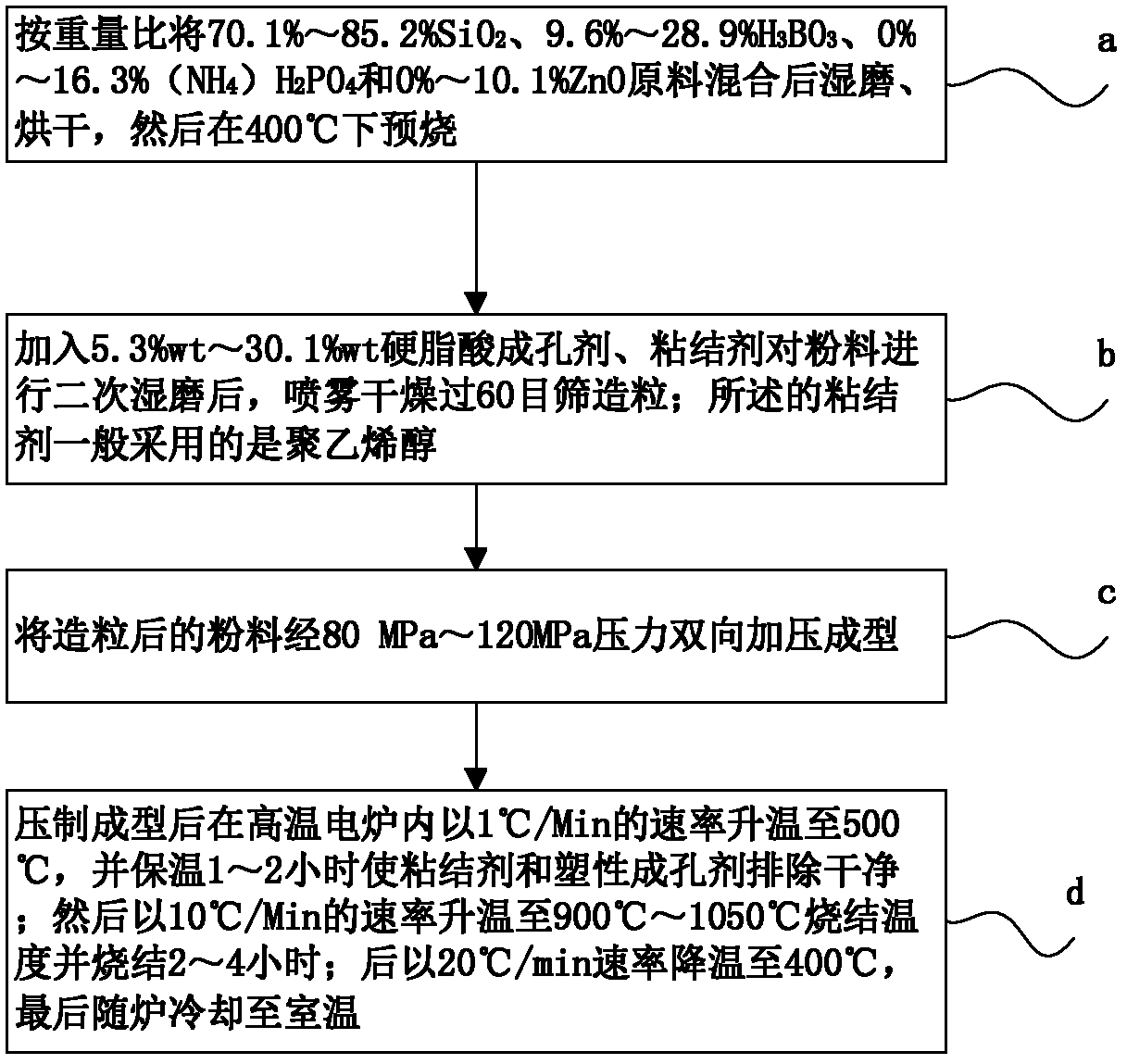Porous glass ceramic material, preparation method and prepared metamaterial substrate
A technology of porous glass ceramics and substrates, applied in the direction of electrical components, antennas, etc., can solve problems such as limited effects, achieve low dielectric constant, scientific and reasonable preparation methods, and widely used effects
- Summary
- Abstract
- Description
- Claims
- Application Information
AI Technical Summary
Problems solved by technology
Method used
Image
Examples
Embodiment 1
[0038] 74.5% SiO by weight 2 , 13.6%H 3 BO 3 , 7.4% (NH 4 )H 2 PO 4 Mix with 4.5% ZnO raw materials and add ethanol, use alumina balls as ball mills, mill in a planetary ball mill for 4 hours, then dry at 80°C for 12 hours, and pre-calcine the dried powder at 400°C for 2 hours;
[0039]Add 15.5%wt stearic acid pore-forming agent and 5.2%wt polyvinyl alcohol binder to the pre-calcined powder for secondary ball milling, spray dry and pass through a 60-mesh sieve for granulation, and the granulated powder The material is formed by two-way pressure at 120MPa; after compression molding, the temperature is slowly raised to 500°C at a rate of 1°C / min in a high-temperature electric furnace, and kept for 2 hours to ensure that the polyvinyl alcohol binder and stearic acid pore-forming agent are completely removed. Then rapidly raise the temperature at 10°C / min to the highest firing temperature of 950°C, and keep it warm for 3 hours, then cool down to 400°C at a cooling rate of 20°...
Embodiment 2
[0042] 74.5% SiO by weight 2 , 13.6%H 3 BO 3 , 11.9% (NH 4 )H 2 PO 4 Mix with 0% ZnO raw materials and add ethanol, use alumina balls as ball mills, mill in a planetary ball mill for 4 hours, then dry at 80°C for 12 hours, and pre-calcine the dried powder at 400°C for 2 hours;
[0043] Add 10.5%wt stearic acid pore-forming agent and 5.2%wt polyvinyl alcohol binder to the pre-calcined powder for secondary ball milling, spray dry and pass through a 60-mesh sieve for granulation, and the granulated powder The material is formed by two-way pressure at 120MPa; after compression molding, the temperature is slowly raised to 500°C at a rate of 1°C / min in a high-temperature electric furnace, and kept for 2 hours to ensure that the polyvinyl alcohol binder and stearic acid pore-forming agent are completely removed. Then rapidly raise the temperature at 10°C / min to the highest firing temperature of 950°C, and keep it warm for 2 hours, then cool down to 400°C at a cooling rate of 20°...
Embodiment 3
[0046] 74.5% SiO by weight 2 , 13.6%H 3 BO 3 , 2.1% (NH 4 )H 2 PO 4 Mix with 9.8% ZnO raw material and add ethanol, use alumina balls as ball mills, mill in a planetary ball mill for 4 hours, then dry at 80°C for 12 hours, and pre-calcine the dried powder at 400°C for 2 hours;
[0047] Add 12.5%wt stearic acid pore-forming agent and 5.2%wt polyvinyl alcohol binder to the pre-calcined powder for secondary ball milling, spray dry and pass through a 60-mesh sieve for granulation, and the granulated powder The material is formed by two-way pressure at 120MPa; after compression molding, the temperature is slowly raised to 500°C at a rate of 1°C / min in a high-temperature electric furnace, and kept for 2 hours to ensure that the polyvinyl alcohol binder and stearic acid pore-forming agent are completely removed. Afterwards, the temperature was rapidly raised to a maximum firing temperature of 950°C at 10°C / min, and kept at a temperature of 4 hours, then cooled to 400°C at a cool...
PUM
| Property | Measurement | Unit |
|---|---|---|
| dielectric loss | aaaaa | aaaaa |
| dielectric loss | aaaaa | aaaaa |
| dielectric loss | aaaaa | aaaaa |
Abstract
Description
Claims
Application Information
 Login to View More
Login to View More - R&D
- Intellectual Property
- Life Sciences
- Materials
- Tech Scout
- Unparalleled Data Quality
- Higher Quality Content
- 60% Fewer Hallucinations
Browse by: Latest US Patents, China's latest patents, Technical Efficacy Thesaurus, Application Domain, Technology Topic, Popular Technical Reports.
© 2025 PatSnap. All rights reserved.Legal|Privacy policy|Modern Slavery Act Transparency Statement|Sitemap|About US| Contact US: help@patsnap.com

